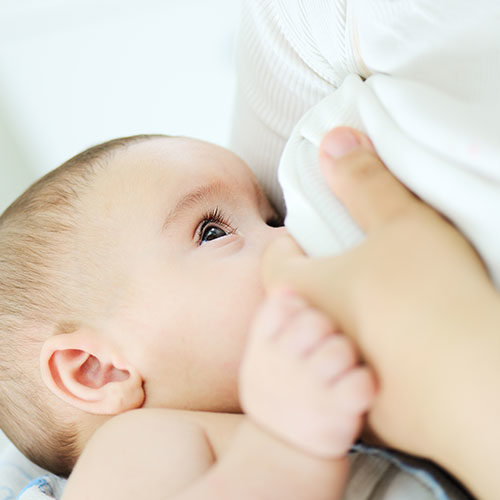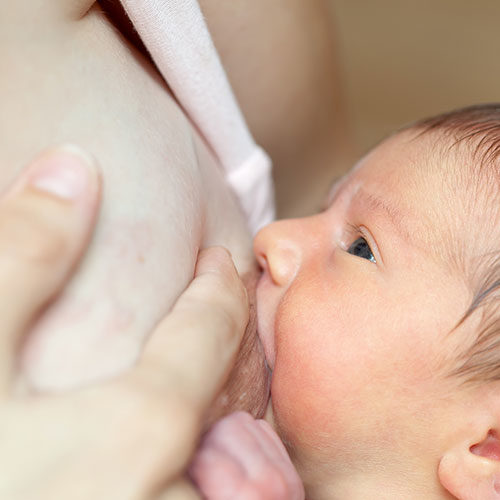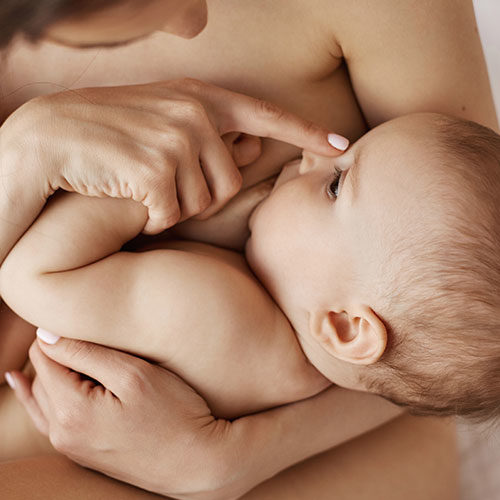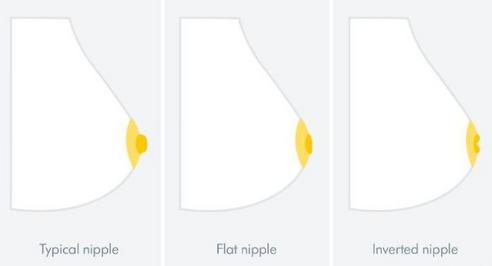Can a mother successfully breastfeed with Flat/Inverted Nipples.
Just like breasts, nipples too come in different sizes and shapes. Many times, the same woman may have nipples of more or less different sizes and shapes on each of her breasts.
A lot of times, women who are told they have flat or inverted nipple(s), really don’t. It’s important to understand when a nipple passes to be called flat or inverted. The following image and table are a helpful guide.
1. A typical nipple protrudes from the breast upon stimulation.
2. A flat nipple does not protrude from the breast when stimulated.
3. An inverted nipple retracts or becomes concave when stimulated
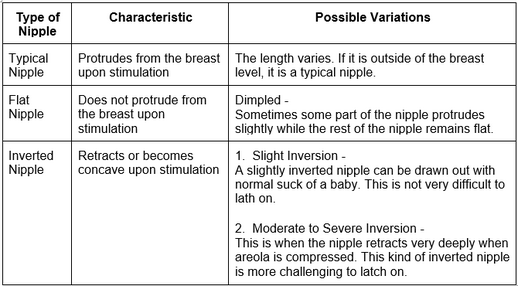
Can a baby latch on a flat or inverted nipple?
At BSIM, we often repeat a quote – “babies breastfeed, they dont nipple feed”. What is implied here is that babies latch on to the breast and not the nipple. Therefore, the shape and size of the nipple can’t be a deciding factor for whether or not a baby can latch. Another very important thing to consider is that – for each baby, the only breast she latches onto, is her mother’s nipple. She doesn’t have the experience to latch onto other breasts. So, a baby is never born with preferences. Preferences are created with experience. Here, that is not the case. That is exactly why, even though it might be a little challenging to nurse with a flat or inverted nipple for the mother as well as the baby, in most cases, the baby figures it out more readily.
Research has suggested that the babies of a mother with flat/inverted nipple(s) are more likely to latch and feed well when
- Breastfeeding is initiated early on
- Bottles and artificial teats are avoided
Having said that, we cannot deny the fact that in some cases, the babies have been unable to latch. We also cannot deny the case-specific conditions that vary along with each case.
Useful Techniques to Draw the nipple out :
Some techniques to draw the nipple out are found to be helpful in latching the baby more comfortably.
Stimulating the nipple manually
- Rolling the nipple between index finger and thumb.
- Touching the nipple with a cold, wet cloth.
- Reverse pressure softening before nursing.
- Pulling back on the breast at the time of latching to make the nipple protrude.
Using certain devices to draw the nipple out
- Breast Shells – They can be worn inside the bra. The pressure helps draw the nipple out. Mother can wear it for a little while before nursing. It is important to note that they should not be worn at night.
- Breast Pumps – Pumping right before nursing can draw the nipple out.
- Syringes – Modified syringes can be used to pull at the nipple and elongate it.
- Nipplette – It is a device that uses suction to draw the nipple out. Its use should be limited to a few minutes before nursing.
- Nipple Shields – Nipple shields are often suggested to the mothers to latch the baby on the breast that has flat or inverted nipple. However, it is not recommended as a quick solution. But should only be considered as the last resort when nothing else works. Read our article on ‘Nipple Shields’ for more information.
Other Useful Tips:
- It is important to follow all the steps to attain a deep latch. Find them in our article on ‘Latch’.
- The Flipple Technique (also called the exaggerated latch technique) may be useful to latch the baby on a breast with a flat/inverted nipple. This technique focuses on getting more breast tissue in the baby’s mouth. This can be particularly helpful here.
- Skin to skin works wonders in inclining the baby to latch on to the breast. More information can be found in our article on ‘Skin to Skin’.
References:
https://www.llli.org/breastfeeding-info/inverted-flat-nipples/
https://www.laleche.org.uk/inverted-nipples/
https://www.breastfeeding.asn.au/bfinfo/inverted-and-flat-nipples
https://ibconline.ca/information-sheets/when-baby-does-not-yet-latch/
Wish to speak with a member of our team who is a certified lactation professional and also an experienced breastfeeding mother, click on this link.
Medical Advice Disclaimer
THIS WEBSITE DOES NOT PROVIDE MEDICAL ADVICE.
The information, including but not limited to, text, graphics, images and other material contained on this website are for informational purposes only. No material on this site is intended to be a substitute for professional medical advice, diagnosis or treatment. Always seek the advice of your physician or other qualified health care provider with any questions you may have regarding a medical condition or treatment before undertaking a new health care regimen, and never disregard professional medical advice or delay in seeking it because of something you have read on this website.
Disclaimer
We understand and acknowledge that parents and babies can be of various genders on a spectrum of LGBTQI+. Families come in diverse flavours. However, in our articles, for the sake of simplicity and convenience, we will be referring to the breastfeeding parent as the mother and using the female pronouns- ‘she’ and ‘her’ for babies. Babies can be nourished and nurtured in different ways and while we have used the terms breastfeeding and nursing, we recognize that parents can opt to chest feed or finger feed.
We don’t have conflicts of interest and declare, and we are compliant with the WHO code of marketing of breastmilk substitutes and the IMS act.
In case you find any information on this website that needs to be updated, please write to us at info@bsim.org.in

